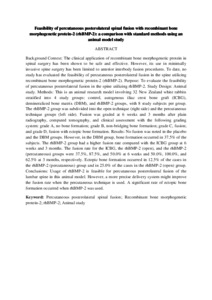Citation
Chan, Chris Yin Wei and Kwan, Mun Keong and Saw, Lim Beng and Hussin, Paisal
(2017)
Feasibility of percutaneous posterolateral spinal fusion with recombinant bone morphogenetic protein-2 (rhBMP-2): a comparison with standard methods using an animal model study.
Clinical Spine Surgery, 30 (2).
138 - 147.
ISSN 2380-0186; ESSN: 2380-0194
Abstract
Background Context: The clinical application of recombinant bone morphogenetic protein in spinal surgery has been shown to be safe and effective. However, its use in minimally invasive spine surgery has been limited to anterior interbody fusion procedures. To date, no study has evaluated the feasibility of percutaneous posterolateral fusion in the spine utilizing recombinant bone morphogenetic protein-2 (rhBMP-2). Purpose: To evaluate the feasibility of percutaneous posterolateral fusion in the spine utilizing rhBMP-2. Study Design: Animal study. Methods: This is an animal research model involving 32 New Zealand white rabbits stratified into 4 study groups: control, autogenous iliac crest bone graft (ICBG), demineralized bone matrix (DBM), and rhBMP-2 groups, with 8 study subjects per group. The rhBMP-2 group was subdivided into the open technique (right side) and the percutaneous technique groups (left side). Fusion was graded at 6 weeks and 3 months after plain radiography, computed tomography, and clinical assessment with the following grading system: grade A, no bone formation; grade B, non-bridging bone formation; grade C, fusion; and grade D, fusion with ectopic bone formation. Results: No fusion was noted in the placebo and the DBM groups. However, in the DBM group, bone formation occurred in 37.5% of the subjects. The rhBMP-2 group had a higher fusion rate compared with the ICBG group at 6 weeks and 3 months. The fusion rate for the ICBG, the rhBMP-2 (open), and the rhBMP-2 (percutaneous) groups were 37.5%, 87.5%, and 50.0% at 6 weeks and 50.0%, 100.0%, and 62.5% at 3 months, respectively. Ectopic bone formation occurred in 12.5% of the cases in the rhBMP-2 (percutaneous) group and in 25.0% of the cases in the rhBMP-2 (open) group. Conclusions: Usage of rhBMP-2 is feasible for percutaneous posterolateral fusion of the lumbar spine in this animal model. However, a more precise delivery system might improve the fusion rate when the percutaneous technique is used. A significant rate of ectopic bone formation occurred when rhBMP-2 was used.
Download File
![[img]](http://psasir.upm.edu.my/61875/1.hassmallThumbnailVersion/Feasibility%20of%20percutaneous%20posterolateral%20spinal%20fusion%20with%20recombinant%20bone%20morphogenetic%20protein-2%20.pdf)  Preview |
|
Text
Feasibility of percutaneous posterolateral spinal fusion with recombinant bone morphogenetic protein-2 .pdf
Download (7kB)
| Preview
|
|
Additional Metadata
Actions (login required)
 |
View Item |

